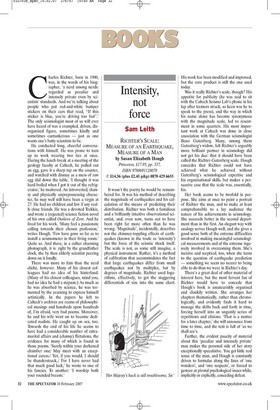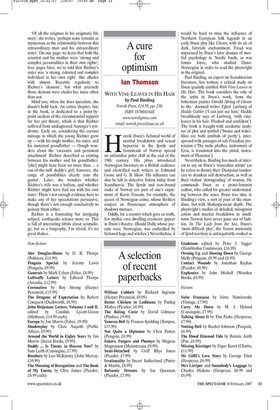Intensity, not force
Sam Leith RICHTER'S SCALE: MEASURE OF AN EARTHQUAKE, MEASURE OF A MAN by Susan Elizabeth Hough Princeton, £17.95, pp. 337, ISBN 9780691128078 © £1436 (plus £2.45 p&p) 0870 429 6655 Charles Richter, born in 1900, was, in the words of his biographer, 'a nerd among nerds: regarded as peculiar and intensely private even by scientists' standards. And we're talking about people who put red-and-white bumper stickers on their cars that read, "If this sticker is blue, you're driving too fast": The only seismologist most of us will ever have heard of was a crumpled, driven, disorganised figure, sometimes kindly and sometimes cantankerous — just as one wants one's batty scientists to be.
He conducted long, cheerful conversations with himself. He was prone to turn up to work wearing two ties at once. During the lunch-break at a meeting of the geology faculty at Caltech, he pulled out an egg, gave it a sharp tap on the counter, and watched with dismay as a mess of raw egg slid down the table. 'I thought it was hard-boiled when I got it out of the refrigerator,' he muttered. An introverted, clumsy and physically unprepossessing character, he may well still have been a virgin at 27. He had no children and few if any really close friends. He was a devoted Trekkie, and wrote a (rejected) science fiction novel of his own called Outlaws of Zem. And he lived for his work. 'Many feel a passionate calling towards their chosen profession,' writes Hough. 'Few have gone so far as to install a seismometer in their living room.' Quite so. And there, in a rather charming photograph, it is: right by the grandfather clock, the by then elderly scientist peering down on it fondly.
There was more to him than the nerd cliché, however. Many of his closest colleagues had no idea of his hinterland. (Many of his closest colleagues, mind you, had no idea he had a stepson.) As much as he was absorbed by science, he was tormented by the yearning to express himself artistically. In the papers he left to Caltech's archives are reams of philosophical musings and hundreds upon hundreds of, I'm afraid, very bad poems. Moreover, he and his wife went on to become dedicated nudists. He caught up on sex, too. Towards the end of his life he seems to have had a considerable number of extramarital affairs and (clumsy) flirtations, the evidence for many of which is found in those poems. 'Surely within your darkened chamber one/ May meet with an exceptional caress./ Yet, if you would, I should be thunderstruck,! For I have never had that much good luck,' he wrote to one of his fancies. To another: 'I worship both your rounded breasts.'
It wasn't the poetry he would be remembered for. It was his method of describing the magnitude of earthquakes and his calculation of the means of predicting their distribution. Richter was both a fastidious and a brilliantly intuitive observational scientist, and, even now, turns out to have been right far more often than he was wrong. 'Magnitude', incidentally, describes not the chimney-toppling effects of earthquakes (known in the trade as 'intensity') but the force of the seismic shock itself. The scale is not, as some still imagine, a physical instrument. Rather, it's a method of calibration that accommodates the fact that large earthquakes differ from small earthquakes not by multiples, but by degrees of magnitude. Richter used logarithms, effectively, to get the staggering differentials of size into the same chart.
His work has been modified and improved, but the core product is still the one used today.
Was it really Richter's scale, though? His appetite for publicity (he was said to sit with the Caltech Seismo Lab's phone in his lap after tremors struck, so keen was he to speak to the press), and the way in which his name alone has become synonymous with the magnitude scale, led to resentment in some quarters. His most important work at Caltech was done in close association with the German seismologist Beno Gutenberg. Many, among them Gutenberg's widow, felt Richter's arguably more brilliant partner in seismology did not get his due: that it should have been called the Richter-Gutenberg scale. Hough concedes that Richter could not have achieved what he achieved without Gutenberg's seismological expertise and his organisational skills, but makes a persuasive case that the scale was, essentially, his.
Her book seems to be twofold in purpose. She aims at once to paint a portrait of Richter the man, and to make at least comprehensible to a lay audience the nature of his achievements in seismology. She succeeds better in the second department than in the first. An elegant way with analogy serves Hough well, and she gives a good sense both of the extreme difficulties involved in making meaningful seismological measurements and of the extreme ingenuity involved in overcoming them. She's incisive and sceptical, too, when she turns to the question of earthquake prediction — something we seem no nearer to being able to do than we were in Richter's day.
There's a great deal of other material of interest here, but the most fervent fan of Richter would have to concede that Hough's book is amateurishly organised and clunkily written. She arranges her chapters thematically, rather than chronologically, and evidently finds it hard to manage the shifts back and forth in time, forcing herself into an ungainly series of repetitions and elisions. 'That is a matter for a later chapter,' she will announce from time to time, and the text is full of 'as we shall see's.
Further, the evident paucity of material about this 'peculiar and intensely private' man makes the personal side of her story exceptionally speculative. You get little real sense of the man, and Hough is constantly driven to formulas along the lines of 'one wonders', and 'one suspects', or forced to gesture at pivotal psychological issues while, implicitly or explicitly, conceding defeat.
'Of all the enigmas in his enigmatic life story,' she writes, 'perhaps none remains as mysterious as the relationship between this extraordinary man and his extraordinary sister.' On one page, we learn that both the scientist and his mother were 'strong and complex personalities in their own rights'; four pages later, we're told that Richter's sister was 'a strong, talented and complex individual in her own right'. She alludes with almost Tourettic regularity to Richter's 'demons', but what precisely those demons were eludes her more often than not.
Mind you, when she does speculate, she doesn't hold back. An entire chapter, late in the book, is dedicated to a point-bypoint analysis of the circumstantial support for her pet theory, which is that Richter suffered from undiagnosed Asperger's syndrome. Early on, considering the curious ménage in which the young Richter grew up - with his single mother, his sister, and his maternal grandfather - Hough wonders about the 'excessive and persistent attachment' Richter described as existing between his mother and his grandfather: Ishel might have been no more than ... a run-of-the-mill daddy's girl; however, the range of possibilities clearly runs the gamut'. Later, she wonders whether Richter's wife was a lesbian, and whether Richter might have had sex with his own sister. There's not enough evidence here to make any of her speculations persuasive, though there's not enough conclusively to gainsay them either.
Richter is a frustrating but intriguing subject; earthquake science more so. This is full of interesting titbits about seismology; but as a biography, I'm afraid, it's no great shakes.














































 Previous page
Previous page